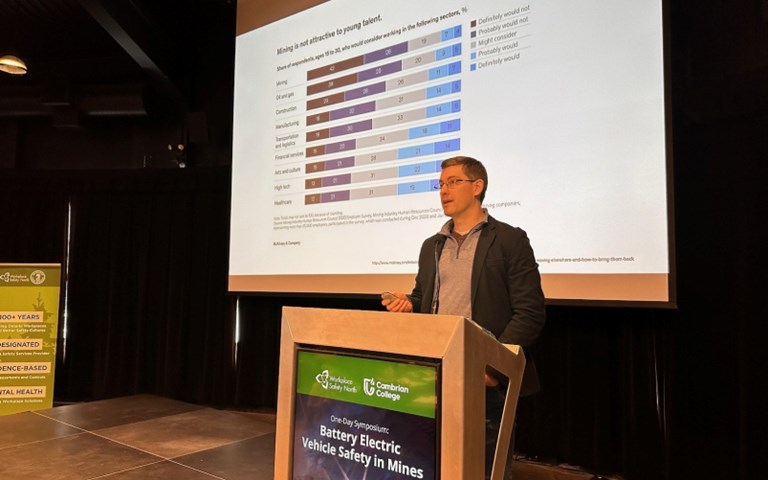David Francis Lyon outlines the training gaps that need to be addressed to accelerate BEV adoption in Canada. Courtesy of Workplace Safety North via X (the platform formerly known as Twitter).
David Francis Lyon, founder and president of engineering company Zero Nexus, spoke about the gaps in specialized training needed to prepare the mining workforce for electrification at the Battery Electric Vehicle Safety in Mines Symposium in Sudbury on Feb. 15.
“Canada is by far the leader in [battery electric vehicle] adoption, but there’s still a long way to go,” Lyon said.
The one-day event, hosted by Workplace Safety North (WSN), was attended by hundreds of people at Cambrian College and virtually through live streaming.
In Lyon’s presentation titled, “Plugged In and Prepared: Understanding Training Needs for Electric Mobile Mining Equipment,” he outlined the results of a Zero Nexus qualitative research project that involved more than 100 virtual and on-site interviews with battery electric vehicle (BEV) machine operators, shift managers, mine planners and other industry stakeholders at operating mines in Canada that are trialling BEV equipment.
“We were really looking for information, both good and bad, to help us assess the needs,” he said.
Lyon said the research showed that there is a need to develop a collective base of knowledge on best practices for operationalizing BEVs. Some of the training opportunities identified included general BEV safety, as well as charging and maintenance safety.
In a follow-up statement to CIM Magazine, Lyon wrote that while visiting mine sites to conduct the research, the Zero Nexus team found that a mining company trialling BEV equipment is usually forced to develop its own training program for its workers, which is a process that takes several years; BEVs are not generally a plug-and-play solution.
“Despite best efforts to coordinate between mining companies, each operation ended up making their own version of site-specific training,” Lyon wrote. “We see this as a hurdle for miners at early stages since this data collection activity for finding best practices is lengthy.”
As part of its research, Zero Nexus also hosted two short courses at last year’s CIM Convention and Expo and CIM MEMO to gather feedback from mine operators, OEMs and other service providers currently using BEVs or interested in adopting BEVs. Lyon stated that a recurring theme from participants was a desire to learn more about battery chemistry and the full life cycle analysis of BEVs from a third-party, unbiased source.
“The other thing that we heard a lot was that people are looking for more applications and case studies as BEVs grow in popularity,” he said. “A big one was that there’s no rule of thumb. There’s no playbook that exists right now in the industry for how to operate [BEV] machines as a fleet.”
Lyon’s presentation emphasized that the different roles within mining operations involved in adopting BEV equipment also require job-specific training, from operators that are responsible for battery user-interface and charging, to electricians that must service BEV-specific high-voltage electric equipment.
He said that while there are some institutions in Canada that offer training programs, they tend to focus on skilled trades or are part of engineering programs that focus on the development of BEVs.
“There exists a gap in addressing the planning stages for BEVs,” he said. “By planning stages, I mean, everyone who isn’t an operator. I think that gap exists globally. Just understanding the nuances of the technology and the terminology, that’s very important. From the operator’s side, it felt like [text-book based and online] training may not be as critical… hands-on experience tends to be the most effective and addresses challenges more effectively than anything in a book. And on the mine maintenance side, there’s a steep learning curve… it necessitates a much more comprehensive training approach.”
Zero Nexus is currently working on designing and developing courses that cover battery technology fundamentals, safety principles, fleet management and the broader landscape of BEV integration in mining for CIM Academy.
“How to use EVs is the gap we hope we can help fill,” Lyon wrote.
The workforce research is segmented into mine maintenance, operations and planning, and mine management, and Zero Nexus will soon release a white paper publicly sharing the results of the research.




